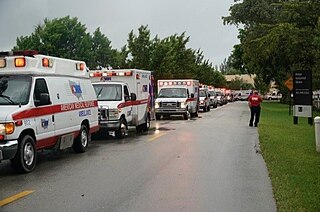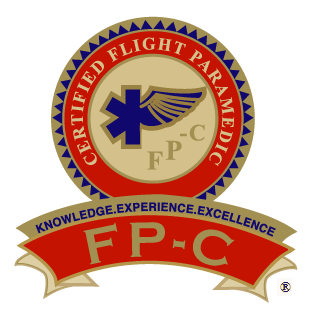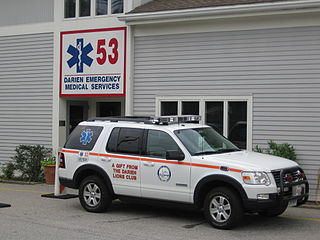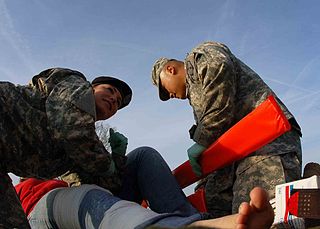
The National Registry of Emergency Medical Technicians is a US certification agency covering prehospital medical providers.

The National Registry of Emergency Medical Technicians is a US certification agency covering prehospital medical providers.
The NREMT was established in 1970 in response to a recommendation from President Lyndon Johnson's Committee on Highway Traffic Safety that a national certifying agency for Emergency Medical Technicians be created in order to establish and standardize training requirements. [1]
National Standard Curriculum as defined by the Department of Transportation - National Highway Traffic Safety Administration (NHTSA)
Most states use or require NREMT testing for some level of state certification. [1] [2] [3] NREMT recognizes four levels of EMS: EMR, EMT, Advanced EMT, and Paramedic (some states may have additional certifications). [2] NREMT certification at an EMT Intermediate level may or may not be sufficient for some state EMT-I requirements. [4] While NREMT certification may be mandatory for new state certification, it is not necessarily required for renewals. [4] These procedures and requirements vary from state to state. In 1986, military emergency rooms were required to certify all medical technicians through NREMT. [5]
The NREMT launched the EMS-ID system on January 23, 2020, modeled after the National Provider Identifier (NPI). The idea was that one identifier could be issued to a verified individual upon creation of an NREMT account, which could then reference all certifications for that person. The number would remain constant, even if the individual changed their name, national certification level, etc. [7] Similar to the NPI number issued by the Centers for Medicare and Medicaid Services (CMS), the number is a 12-position, intelligence-free numeric identifier (12-digit number). The EMS-ID is not intended to replace the individual registry number. [8]
The NREMT was criticized in 2010 for failing to prevent cheating during some exams. The Washington, D.C. Fire Department [9] was investigated for cheating on the NREMT certification exam; [10] however, an extensive investigation [11] by the NREMT, Pearson VUE (the test administrator), with assistance from the DC Fire and EMS department [12] and the DC police, revealed no evidence of cheating at Pearson VUE's LaPlata, MD testing center.[ citation needed ]
The NREMT works with the EMS community to implement the National EMS System including the EMS Agenda for the Future, [13] EMS Education Agenda: A Systems Approach, [14] and National Scope of Practice Model. [15]

Emergency medical services (EMS), also known as ambulance services or paramedic services, are emergency services that provide urgent pre-hospital treatment and stabilisation for serious illness and injuries and transport to definitive care. They may also be known as a first aid squad, FAST squad, emergency squad, ambulance squad, ambulance corps, life squad or by other initialisms such as EMAS or EMARS.

An emergency medical technician (EMT), also known as an ambulance technician, is a health professional that provides emergency medical services. EMTs are most commonly found working in ambulances. In English-speaking countries, paramedics are a separate profession that has additional educational requirements, qualifications, and scope of practice.

A paramedic is a healthcare professional who responds to emergency calls for medical help outside of a hospital. Paramedics mainly work as part of the emergency medical services (EMS), most often in ambulances. The scope of practice of a paramedic varies among countries, but generally includes autonomous decision making around the emergency care of patients.

A certified first responder is a person who has completed a course and received certification in providing pre-hospital care for medical emergencies. Certified individuals should have received much more instruction than someone who is trained in basic first aid and cardiopulmonary resuscitation (CPR) but they are not necessarily a substitute for more advanced emergency medical care rendered by emergency medical technicians (EMTs) and paramedics. First responders typically provide advanced first aid level care, CPR, and automated external defibrillator (AED) usage. The term "certified first responder" is not to be confused with "first responder", which is a generic term referring to the first medically trained responder to arrive on scene and medically trained telecommunication operators who provide pre-arrival medical instructions as trained Emergency Medical Dispatchers (EMD). Many police officers and firefighters are required to receive training as certified first responders. Advanced medical care is typically provided by EMS, although some police officers and firefighters also train to become emergency medical technicians or paramedics.

The Star of Life is a symbol used to identify emergency medical services. It features a blue six-pointed star outlined by a white border. The middle contains a Rod of Asclepius – an ancient symbol of medicine. The Star of Life can be found on ambulances, medical personnel uniforms, and other objects associated with emergency medicine or first aid. Elevators marked with the symbol indicate the lift is large enough to hold a stretcher. Medical bracelets sometimes use the symbol to indicate one has a medical condition that emergency services should be aware of.

In the United States, the paramedic is a professional whose primary focus is to provide advanced emergency medical care for critical and emergency patients who access Emergency Medical Services (EMS). This individual possesses the complex knowledge and skills necessary to provide patient care and transportation. Paramedics function as part of a comprehensive EMS response, under medical oversight. Paramedics perform interventions with the basic and advanced equipment typically found on an ambulance. The paramedic is a link from the scene into the health care system. One of the eligibility requirements for state certification or licensure requires successful completion of a nationally accredited Paramedic program at the certificate or associate degree level. Each state varies in requirements to practice as a paramedic, and not all states require licensure.
Advanced Emergency Medical Technician - Critical Care (AEMT-CC) is an Emergency Medical Services (EMS) certification unique to New York. The curriculum for AEMT-CC's in New York is similar to that of the national standard EMT-I/99 but with a broader scope of practice. EMT-CCs are fully classified as Advanced Life Support (ALS) providers within New York and are trained in advanced airway management, including intubation, IV fluid administration, cardiac monitoring, cardiac pacing, and both synchronized and unsynchronized cardioversion, and medication usage/administration in adult and pediatric patients.

The Flight paramedic Certification (FP-C) is an advanced certification that indicates an individual has attained the designation of Certified Flight Paramedic. The FP-C certification exam is administered by the International Board of Specialty Certification (IBSC), a not-for-profit organization responsible for the administration and development of specialty certification exams for critical care professionals. The FP-C exam was the first specialty paramedic certification offered by the Board for Critical Care Transport Paramedic Certification in 2000. This certification is designed for experienced paramedics who have demonstrated advanced knowledge of critical care medicine.

Louisville Metro Emergency Medical Services is the primary provider of pre-hospital life support and emergency care within Louisville-Jefferson County, Kentucky. LMEMS is a governmental department that averages 90,000 calls for service, both emergency and non-emergency, each year.

In the United States, emergency medical services (EMS) provide out-of-hospital acute medical care and/or transport to definitive care for those in need. They are regulated at the most basic level by the National Highway Traffic Safety Administration, which sets the minimum standards that all states' EMS providers must meet, and regulated more strictly by individual state governments, which often require higher standards from the services they oversee.
In the US, paramedicine is the physician-directed practice of medicine, often viewed as the intersection of health care, public health, and public safety. While discussed for many years, the concept of paramedicine was first formally described in the EMS Agenda for the Future. Paramedicine represents an expansion of the traditional notion of emergency medical services as simply an emergency response system. Paramedicine is the totality of the roles and responsibilities of individuals trained and credentialed as EMS practitioners. These practitioners have been referred to as various levels of Emergency Medical Technician (EMTs). In the United States paramedics represent the highest practitioner level in this domain. Additional practitioner levels in this domain within the U.S. include Emergency Medical Responders (EMRs), Emergency Medical Technicians (EMTs) and Advanced Emergency Medical Technicians (AEMTs).
Advanced emergency medical technicians (AEMT) are providers of prehospital emergency medical services in the United States. A transition to this level of training from the emergency medical technician-intermediate (EMT-I), which have somewhat less training, began in 2013 and has been implemented by most states at this point. The AEMT is not intended to deliver definitive medical care in most cases, but rather to augment prehospital critical care and provide rapid on-scene treatment. AEMTs are most usually employed in ambulance services, working in conjunction with EMTs and paramedics, however are also commonly found in fire departments and law enforcement agencies as non-transporting first responders. Ambulances operating at the AEMT level of care are commonplace in rural areas, and occasionally found in larger cities as part of a tiered-response system, but are overall much less common than EMT- and paramedic-level ambulances. The AEMT provides a low-cost, high-benefit option to provide advanced-level care when the paramedic level of care is not feasible. The AEMT is authorized to provide limited advanced life support, which is beyond the scope of an EMT.
Emergency Medical Technician is the entry level of Emergency Medical Technician in the United States.
In the United States, the licensing of prehospital emergency medical providers (EMTs) and oversight of emergency medical services are governed at the state level. Each state is free to add or subtract levels as each state sees fit. Therefore, due to differing needs and system development paths, the levels, education requirements, and scope of practice of prehospital providers varies from state to state. Even though primary management and regulation of prehospital providers is at the state level, the federal government does have a model scope of practice including minimum skills for EMRs, EMTs, Advanced EMTs and Paramedics set through the National Highway Traffic Safety Administration (NHTSA).

Emergency medical responders are people who are specially trained to provide out-of-hospital care in medical emergencies. There are many different types of emergency medical responders, each with different levels of training, ranging from first aid and basic life support. Emergency medical responders have a very limited scope of practice and have the least amount of comprehensive education, clinical experience or clinical skills of emergency medical services (EMS) personnel. The EMR program is not intended to replace the roles of emergency medical technicians or paramedics and their wide range of specialties. Emergency medical responders typically assist in rural regions providing basic life support where pre-hospital health professionals are not available due to limited resources or infrastructure.
Emergency medical services in Sri Lanka is being established using a public/private system aimed at the provision of emergency ambulance service, including emergency care and transportation to hospitals. The Pre-Hospital Care Committee is part of the Trauma Secretariat of the Sri Lanka Ministry of Healthcare and Nutrition and was established following the 2004 tsunami. The goal of the Pre-Hospital Care Sub-Committee is “During this generation and continuing for future generations, everyone in Sri Lanka will have access to trained pre-hospital medical personnel, ambulances are available to transport the sick and injured safely to hospitals, complications from harmful or inadequate pre-hospital care is eliminated so physician and nursing personnel at hospitals are delivered patients they are able to professionally treat and rehabilitate back to society as contributing citizens.” Pre-Hospital care is an essential, core component of trauma system.
Immediate Life Support (ILS) is a level of training undertaken in order to provide emergency medical care outside medical facilities. ILS is classed as mid-level emergency medical care provided by trained first responders who receive more training than basic life support providers, but less as advanced life support providers. Immediate Life Support is also known as Limited Advanced Life Support (LALS).

The Recognition of EMS Personnel Licensure Interstate CompAct, also known as "REPLICA", is an interstate compact that extends a "privilege to practice" in the United States from a 'home state' to 'remote states' for qualified Emergency Medical Services personnel. For a state to participate in the compact, a state must pass the model legislation into law. On October 11, 2017, when Georgia signed the REPLICA legislation into law, the EMS Compact was formalized and the Interstate Commission for EMS Personnel Practice was established.
William 'Will' R. Smith, is an emergency physician and wilderness medicine consultant who lectures about integrating combat medicine into wilderness rescues around the world. He started Wilderness & Emergency Medicine Consulting, a company that helps people with pre-trip planning, online medical support, travel medicine in remote areas and provides expert witness testimony in court cases related to wilderness medicine. As medical director for the National Park Service, he oversaw the largest rescue event ever to occur in Grand Teton National Park. He lives in Jackson, Wyoming where he is an emergency medicine physician at St. John’s Medical Center.